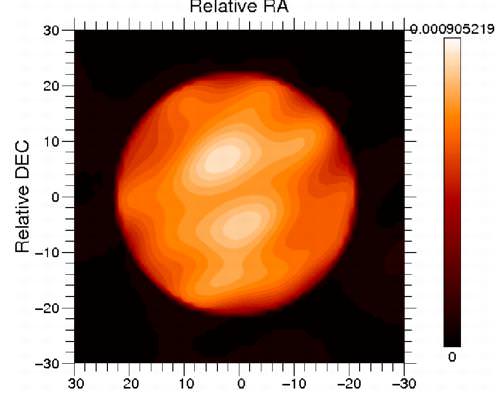
Caption:The surface of Betelgeuse in near infrared at 1.64 micron in wavelength, obtained with the IOTA interferometer (Arizona). The image has been re-constructed with two different algorithms, which yield the same details, of 9 milliarcseconds (mas). The star diameter is about 45 milliarcseconds. Credit: Copyright 2010 Haubois / Perrin (LESIA, Observatoire de Paris)
An international team of astronomers has obtained an unprecedented image of the surface of the red supergiant Betelgeuse, in the constellation Orion. The image reveals the presence of two giant bright spots, which cover a large fraction of the surface. Their size is equivalent to the Earth-Sun distance. This observation provides the first strong and direct indication of the presence of the convection phenomenon, transport of heat by moving matter, in a star other than the Sun. This result provides a better understanding of the structure and evolution of supergiants.
Betelgeuse is a red supergiant located in the constellation of Orion, and is quite different from our Sun. First, it is a huge star. If it were the center of our Solar System it would extend to the orbit of Jupiter. At 600 times larger than our Sun, it radiates approximately 100,000 times more energy. Additionally, with an age of only a few million years, Betelgeuse is already nearing the end of its life and is soon doomed to explode as a supernova. When it does, the supernova should be seen easily from Earth, even in broad daylight.
But we now know Betelgeuse has some similarities to the Sun, as it also has sunspots. The surface has bright and dark spots, which are actually regions that are hot and cold spots on the star. The spots appear due to convection, i.e., the transport of heat by matter currents. This phenomenon is observed every day in boiling water. On the surface of the Sun, these spots are rather well-known and visible. However, it is not at all the case for other stars and in particular supergiants. The size, physical characteristics, and lifetime of these dynamical structures remain unknown.
Betelgeuse is a good target for interferometry because its size and brightness make it easier to observe. Using simultaneously the three telescopes of the Infrared Optical Telescope Array (IOTA) interferometer on Mount Hopkins in Arizona (since removed), and the Paris Observatory (LESIA) the astronomers were able to obtain a numerous high-precision measurements. These made it possible to reconstruct an image of the star surface thanks to two algorithms and computer programs.
more:
http://www.universetoday.com/2010/01/12/unprecedented-images-show-betelgeuse-has-sunspots/